Recent trends in airway management
- PMID: 32489647
- PMCID: PMC7222034
- DOI: 10.12688/f1000research.21914.1
Recent trends in airway management
Abstract
Clinical airway management continues to advance at a fast pace. To help update busy anesthesiologists, this abbreviated review summarizes notable airway management advances over the past few years. We briefly discuss advances in video laryngoscopy, in flexible intubation scopes, in jet ventilation, and in extracorporeal membrane oxygenation (ECMO). We also discuss noninvasive ventilation in the forms of high-flow nasal cannula apneic oxygenation and ventilation and nasal continuous positive airway pressure (CPAP) masks. Emerging concepts related to airway management, including the physiologically difficult airway and lower airway management, new clinical subspecialties and related professional organizations such as Anesthesia for Bronchoscopy, the Society for Head and Neck Anesthesia, and fellowship training programs related to advanced airway management are also reviewed. Finally, we discuss the use of checklists and guidelines to enhance patient safety and the value of large databases in airway management research.
Keywords: Airway Management; Jet ventilation; Lower Airway Management; Videolaryngoscope; the physiologically difficult Airway.
Copyright: © 2020 Abdelmalak BB and Doyle DJ.
Conflict of interest statement
Competing interests: The authors receive royalties from the sales of two related textbooks that they co-edited: Anesthesia for Otolaryngologic Surgery and Clinical Airway Management: An Illustrated Case-Based Approach published by Cambridge University Press, London, UK.No competing interests were disclosed.No competing interests were disclosed.No competing interests were disclosed.
Figures










References
-
- Doyle DJ: The GlideScope Video Laryngoscope: A Narrative Review. TOATJ. 2017;11:48–67. 10.2174/1874321801711010048 - DOI
-
- Schechtman SA, Mathis M, Muller G, et al. : A retrospective analysis of factors associated with difficult endotracheal tube passage with use of the hyper-angled GlideScope blade. Journal of Head & Neck Anesthesia. 2019;3:e14 10.1097/HN9.0000000000000014 - DOI
Publication types
MeSH terms
LinkOut - more resources
Full Text Sources
Miscellaneous

